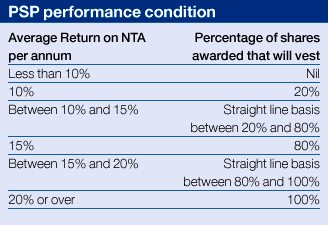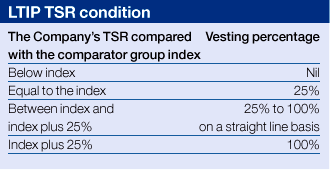Accountability
Directors’ remuneration report
Longer term performance rewards: long term incentive plan for non-underwriting directors and other senior management (Performance Share Plan)
The Performance Share Plan 2004 (PSP) is intended as an aid to the recruitment, retention, motivation and reward of a small number of key senior executives who are not underwriters, including relevant executive directors. Awards have been made each year since 2004 in the form of conditional nil cost share options. Awards are at the discretion of the Committee, with no individual receiving an annual award over shares valued on grant at more than 100% of base salary. In March 2007 awards were made to 13 participants (2006: 15) over an aggregate of 359,581 shares (2006: 385,120). The Committee intends to continue making similar annual awards, although the criteria for inclusion may vary.
The extent to which awards vest depends on a sliding scale of the Group’s average annual post tax return on net tangible assets (Return on NTA) over the ensuing five years (this is the same as in previous years although it was then described as return on equity). The Committee believes that such a Return on NTA measure most appropriately aligns participants' and shareholders' interests. This absolute performance measure balances the relative measures that apply to the Group’s executive share options and long term incentive plan. The average return is calculated after five years, with no re-testing. The targets and scales may vary with each grant at the discretion of the Committee but the scale for all of the grants to date has been as follows:

Once the vesting level is determined after five years, and provided the relevant participant is still employed by the Group, an award can be exercised within the following six months. In certain restricted or exceptional circumstances, an early leaver may be able to exercise early on a pro rata basis. On the Committee’s recommendation, a small rule change in respect of early leavers is being proposed to the 2008 AGM, details of which are given in a separate circular containing the Notice of AGM. The Committee can make adjustments to take account of variations in capital and similar matters. In the event of the Company being subject to a takeover or similar event before the normal vesting date, vesting will take place early to the extent that the Committee is satisfied that the performance condition has been satisfied up to that date, with the proportion of the award which vests also depending on the time that has elapsed since the award was made.
Longer term performance rewards: long term incentive plan for underwriting directors and other senior underwriters (the Capital Builder Plans)
In 2001 the Company first introduced a long term incentive plan for underwriters, the Capital Builder Long Term Incentive Plan 2001 (the 2001 Plan) to reward senior underwriters if they exceed long term target underwriting returns. This plan operated over a five year performance period from 2001 to 2005 inclusive and had 25 participants. The Committee decided in 2005 that the 2001 Plan had acted as a significant reward, retention and recruitment tool for those underwriters who were likely to be most significant in determining the Group’s underwriting profitability and development over the performance period, but that some aspects should be amended. Accordingly in 2006 shareholders agreed to replace the 2001 Plan with the Capital Builder Plan 2006 (the 2006 Plan). Awards were made under the 2006 Plan in 2006 (54 participants) and 2007 (52 participants) and are intended to be made again in 2008.
The basis of both the 2001 and 2006 Plans is that participants benefit to the extent that, in the class or classes of business that they write or influence, demanding underwriting return targets, consistent with the Company achieving an overall average return on equity of at least 15% per annum over the insurance cycle, are exceeded over a five year performance period. For the 2001 Plan target returns for each class were expressed as returns on capital such that, on an aggregated basis and after allowing for estimated expenses and syndicate investment income but before tax, they corresponded to an estimated overall benchmark return on allocated capital of at least 15% per annum over a full insurance cycle. Under the 2001 Plan this was targeted by participants sharing in up to 6% of the relevant underwriting profit (gross premiums less net claims and reinsurance costs) which is in excess of the relevant target . Up to around a further 4% of such excess profits were allocated at a divisional or whole syndicate level to the heads of each underwriting division.
Under the 2001 Plan rewards are being paid in three annual tranches following the end of the single five year performance period (i.e. in 2006, 2007 and 2008) but with payments only being made so long as the participant remains in service. Payments may be made in either cash or shares, at the Company’s discretion, but all payments to date have been made, and are expected to be made, in cash.
For the 2006 Plan:
- In order to provide more transparency to participants but with the same intended long term reward potential, the excess returns are defined as those resulting from the achievement of underwriting loss ratios (i.e. the level of claims, net of reinsurance recoveries, as a percentage of premiums) below (i.e. better than) demanding target claims ratios set for each class.
- The maximum permitted excess profit percentage, although usually lower, is 10%. Variations in each business class’s target claims ratio and excess profit percentage depend on the Committee’s assessment of the risk, historic experience and long term market prospects of the class.
- Rather than operating over a single five year performance period, it has rolling five year performance periods, i.e. for 2006 to 2010, 2007 to 2011 etc, with commensurably lower rewards payable for each performance period.
- The rewards have a cap of £1 million on the total amount that may be paid to a participant in respect of each rolling five year performance period (the 2001 Plan was uncapped).
- Payments will be made over the two years after the end of each performance period, rather than the three years applying to the 2001 Plan. The first payment will be up to 70% of each pool allocated, with the balance paid a year later.
Longer term performance rewards: the Long Term Incentive Plan 2006 (the LTIP)
The LTIP was approved by shareholders at the 2006 AGM to replace grants of executive share options. The first awards were made in March 2007, over a total of 590,630 shares (2006: executive options granted over 2,290,481 shares). Its primary performance condition is a relative Total Shareholder Return (TSR) measure, providing a balance to the absolute performance measures used in the Capital Builder Plans for underwriters and the PSP for non-underwriters. Both senior underwriters and senior non-underwriters, including executive directors, participate in the LTIP.
Awards are made subject to performance conditions set by the Committee at each award. For the awards made in 2007, and those intended to be made in March 2008, the extent to which awards vest will depend on the Company’s TSR over the ensuing three years relative to an unweighted index of TSRs for a comparator group of Lloyd’s insurers, on the following scale:

The constituents of the index for the 2007 awards were: Beazley Group, BRIT Insurance, Catlin Group, Chaucer Holdings, Kiln and Hiscox. Irrespective of relative TSR, no award will vest unless the Committee is satisfied that the Company’s financial performance over the performance period has been satisfactory. The performance period will always be a single three year period with no provision for retesting the performance conditions.
As with the PSP, awards are made in the form of nil cost share options and may be made each year at the discretion of the Committee, based on seniority and with no individual receiving awards over shares having a market value on grant in excess of 100% of annual base salary (or, exceptionally, 200% for a senior new recruit). Once the vesting level is determined after three years, and provided the relevant participant is still employed by the Group, an award is capable of exercise within the following six months. The LTIP contains broadly similar provisions to the PSP, as referred to above, on such matters as early leavers and variations in capital.
Longer term performance rewards: executive share options (Executive Option Schemes)
Executive share option were granted at the discretion of the Committee under the Approved and Unapproved Amlin Executive Share Option Schemes each year from 1997 to 2006 to executive directors and other staff (whether underwriters or not) above a certain level of seniority. Grants were subject to performance conditions which are summarised in respect of directors’ outstanding options in the notes to the table 'Directors' PSP, LTIP and share options held' later in this report. Grants under the Executive Option Schemes were replaced from 2007 with LTIP awards and no further grants can or will be made.
